In another post, I talk about how the Ancient Egyptians held the hippopotamus in high regard. Because much of the old testament is set in Egypt, it is safe to assume that at least some of the people in the old testament were also acquainted with hippopotami.
Yet, the word “hippopotamus” does not occur in the Bible. Many scholars, however, agree that the behemoth mentioned in Job was a hippopotamus. But long before the time of Job, Baby Moses was born in Egypt, and the Bible tells us that he floated to safety in a basket amidst the reeds on the River Nile. Undoubtedly, he shared his water space with hippopotami who were inhabitants of the Nile. In my opinion, Balit’s illustrations for the story of Moses are among the very best.
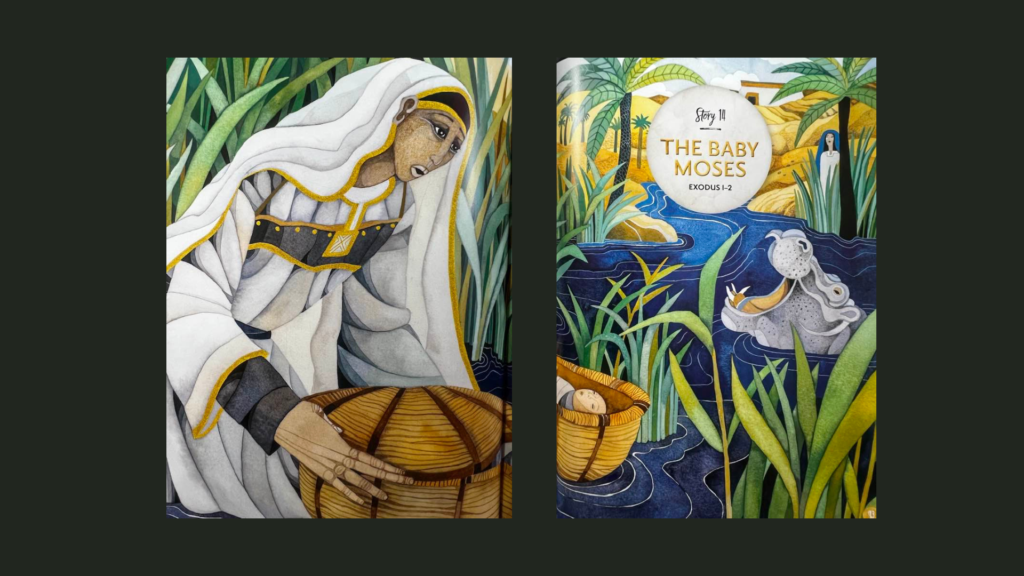
Treasury of Bible Stories – Great for Older Kids, Teens, & Families – Great to Study Design
Many scholars believe that in the Bible, the behemoth is a hippopotamus.
“behemoth. The graphic description of the behemoth in Job 40:15-24 is often thought to refer to the hippopotamus. Sometimes described as “the river horse of Africa,” the hippopotamus is certainly a herbivorous heavyweight, sometimes reaching four tons (three and one-half metric tons). Despite its ungainly, even lethargic appearance, it is versatile in terms of its environment. It can swim or float, sink to the bottom of the river bed, and run along on the bottom. The species Hippopotamus amphibius is found in Central Africa; the pygmy hippopotamus, Choeropsis liberiensis, is found in Liberia. Like the elephant, the hippopotamus is a source of ivory through the large tusks in its lower jaw. There was extensive trading in ivory in biblical times, with at least a dozen biblical references to its use. King Solomon overlaid his ivory throne with gold (1 Ki. 10:18); King Ahab made great use of ivory in his palace. ” Zondervan

“Look at Behemoth,
which I made along with you
and which feeds on grass like an ox.
16 What strength it has in its loins,
what power in the muscles of its belly!
17 Its tail sways like a cedar;
the sinews of its thighs are close-knit.
18 Its bones are tubes of bronze,
its limbs like rods of iron.
19 It ranks first among the works of God,
yet its Maker can approach it with his sword.
20 The hills bring it their produce,
and all the wild animals play nearby.
21 Under the lotus plants it lies,
hidden among the reeds in the marsh.
22 The lotuses conceal it in their shadow;
the poplars by the stream surround it.
23 A raging river does not alarm it;
it is secure, though the Jordan should surge against its mouth.
24 Can anyone capture it by the eyes,
or trap it and pierce its nose? Job 40: 15-24 NIV Bible Gateway
Most Bible scholars now believe that the behemoth in the above book of Job is the hippopotamus.
In the rest of this post, I’ll share what I have discovered that supports this belief:
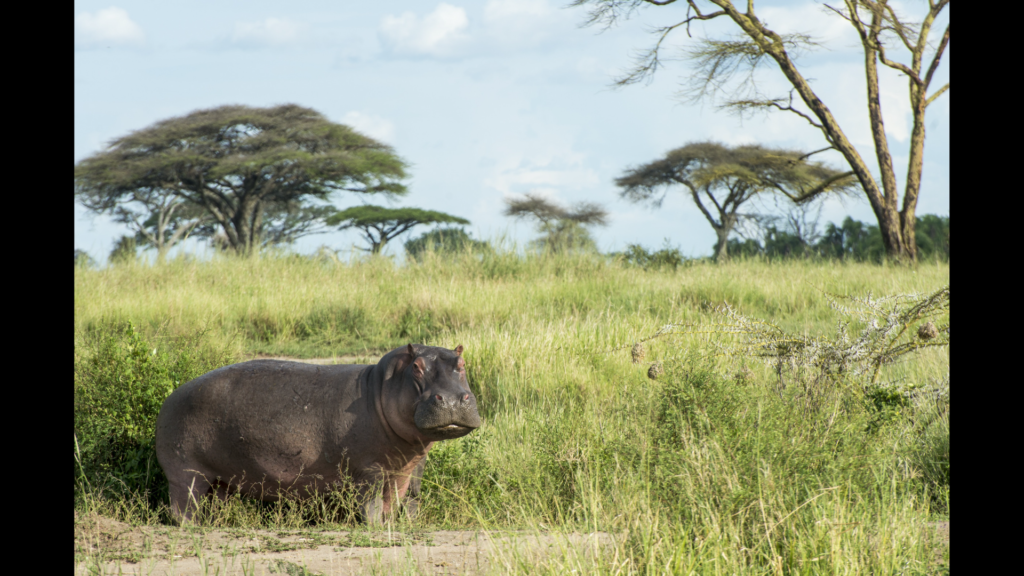
“Look at Behemoth,
which I made along with you
and which feeds on grass like an ox.” Job 40:1 NIV
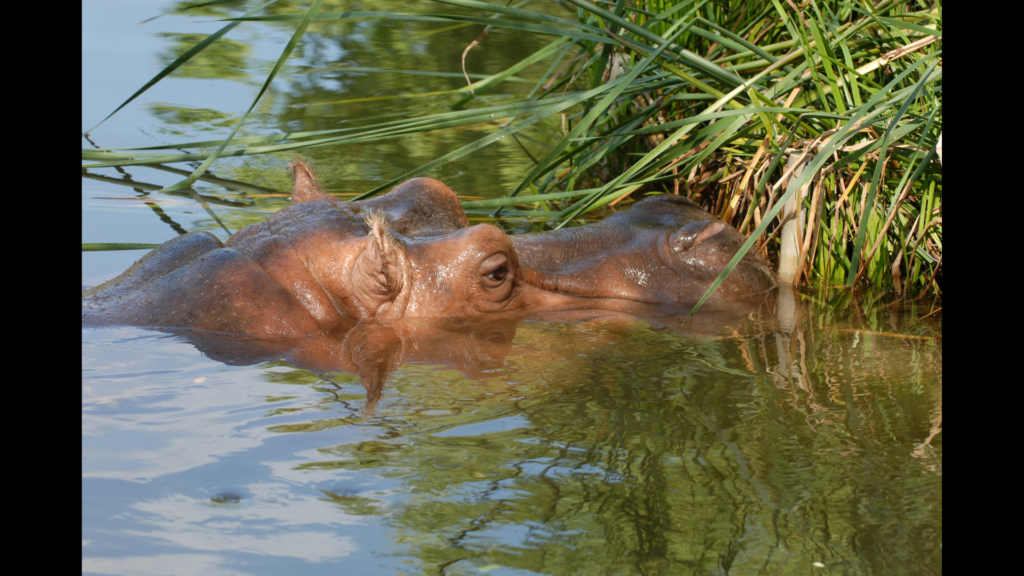
21 Under the lotus plants it lies,
hidden among the reeds in the marsh.
22 The lotuses conceal it in their shadow;
the poplars by the stream surround it.

Image Credit (Wood)

Hippopotamus (“William”)
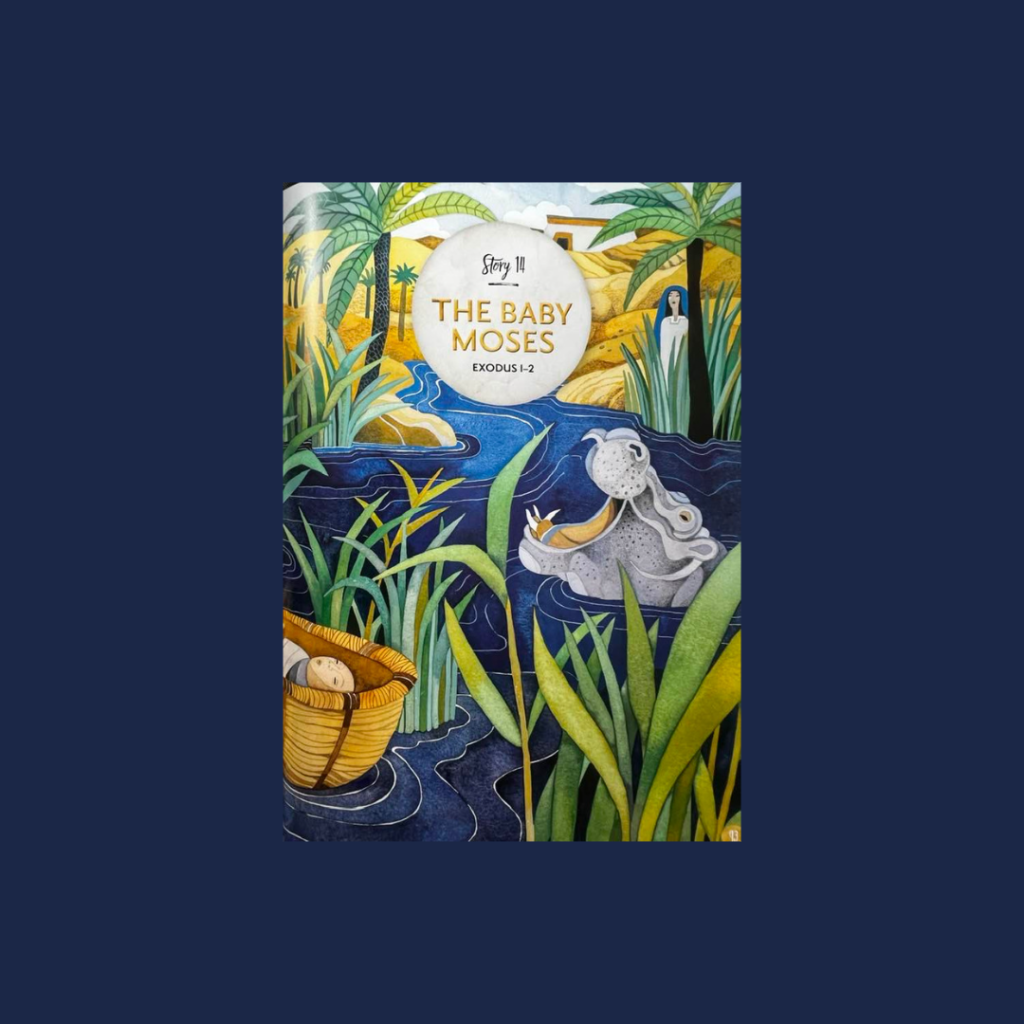
The reference to lotus flowers in Job reminded me of the William Hippo that was created in Ancient Egypt. Lotus flowers are drawn on the hippo’s body. Both lotus flowers and hippos lived in the Nile River, where Baby Moses floated to freedom in a little woven basket.
“Hippos lived in the Nile River, the source of life, so they, too, were associated with life. They often submerge in water for several minutes, surface to breathe, then sink again; this behavior of disappearing and reappearing was associated with regeneration and rebirth. Sometimes only the back of a hippo is visible, which resembles land surrounded by water, an image the Egyptians might have linked with the primeval mound and the beginning of creation. In one Egyptian creation myth, there is the primeval water out of which the primeval mound emerges and on which the sun rises for the first time. In another version of this story, the sun god appears for the first time on top of a lotus flower that arises from the primeval water. The primeval water, the primeval mound, and the lotus flower were thus all connected with creation and life. Another intriguing behavior of hippos is that they roar in the morning at sunrise and in the evening at sunset. The Egyptians possibly interpreted this behavior as a greeting and farewell to the sun. And the sun’s travel was seen as an eternal cycle of rebirth that the deceased hoped to join. Hippopotami were thus associated with life, regeneration, and rebirth.” (Stunkel)
“The decoration of the faience hippos represents the animals’ natural habitat, but in addition these plants and animals also had many positive associations with growth and life. The lotus flower was an especially popular symbol of regeneration and rebirth, since it opens in the morning when the sun appears and closes in the evening. It was linked to the eternal cycle of the death and rebirth of the sun god. The deceased hoped to join the travel of the sun god, in order to be reborn together with him every morning. And, as mentioned above, the lotus flower was also connected to the beginning of creation and thus to life.”(Stunkel)
Stünkel, Isabel. “Hippopotami in Ancient Egypt.” In Heilbrunn Timeline of Art History. New York: The Metropolitan Museum of Art, 2000–. http://www.metmuseum.org/toah/hd/hipi/hd_hipi.htm (November 2017)

Taweret – Minneapolis Institute of Art
“Taweret has the body of a hippo, the legs of a lion, and the face of a crocodile…you can imagine the mythical world in which this goddess walked upright among the reeds of the Nile River, alert to threats, in perpetual protection mode. She was a god of the people, with no real state cult or temple but plenty of believers, at once ubiquitous and inconspicuous. Almost every home, especially one with young children or an expectant mother, would have had an amulet or figurine or feeding cup with her likeness, and a magician-priest might have drawn a circle in the sand around a woman in labor or a sleeping child with an ivory wand made from hippopotamus tusk. She was the god you turned to when your body, like that of Taweret herself, became rounded and full of fragile promise, when life was at stake. … Taweret, after all, was a god of fertility, of life. …
“For a time, there were even several overlapping hippo deities in ancient Egypt. Ipet, Reret, and Hedjet all played essentially the same role as Taweret, and may even have been aspects of the same deity.” (Minneapolis Institute of Art)
Why Taweret Is the Ancient Egyptian Hippo Goddess We Need Now –– Minneapolis Institute of Art. new.artsmia.org/stories/why-taweret-is-the-ancient-egyptian-hippo-goddess-we-need-now.
Admittedly, Tawret and the other hippo deities are not mentioned in the Bible, but again, the stories of the Bible and Ancient Egypt are linked.
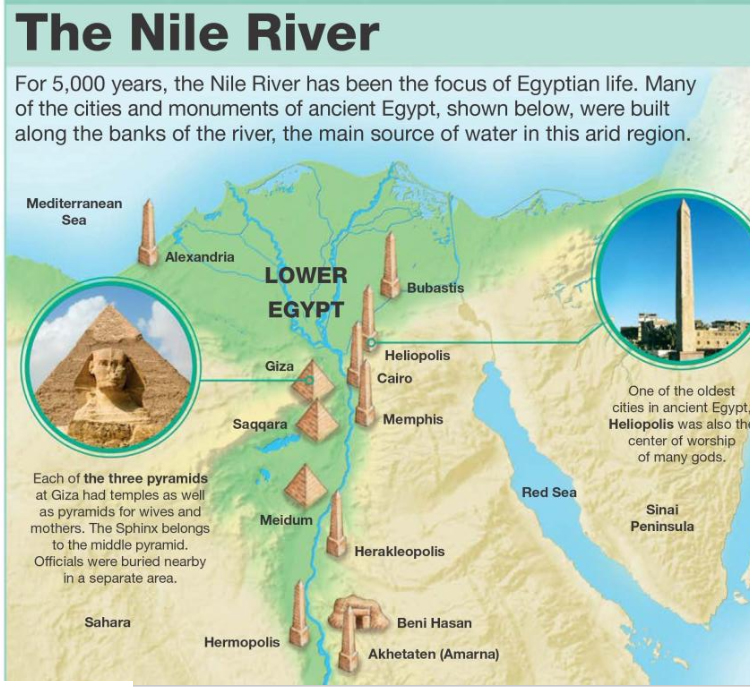
From the Book Ancient Egypt: DK Pocket Guide
Image Credit – Amazon
The Sinai Peninsula, which was formerly part of Israel, is just across the water from Egypt, and Moses parted the waters of the Red Sea to lead his fellow Israelites out of slavery.
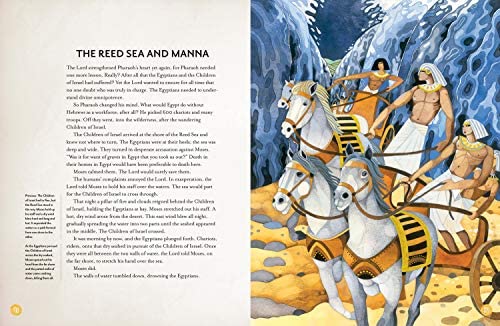
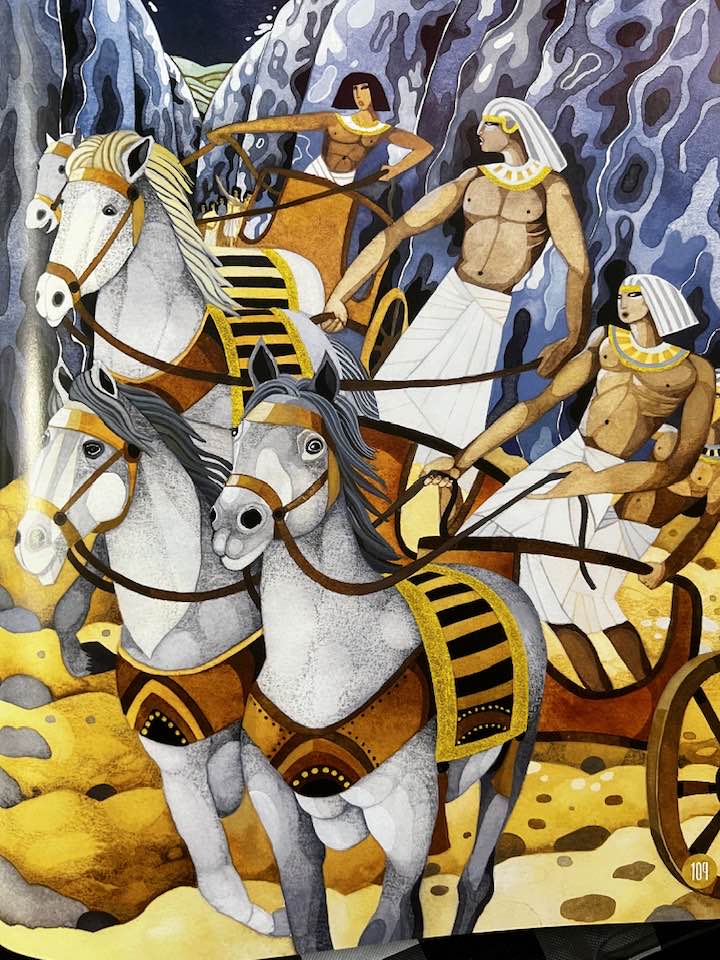
From the Book The Treasury of Bible Stories – Illustration by Balit
Image Credit Amazon
21 Then Moses stretched out his hand over the sea, and all that night the Lord drove the sea back with a strong east wind and turned it into dry land. The waters were divided, 22 and the Israelites went through the sea on dry ground, with a wall of water on their right and on their left. Exodus 19;21-22 NIV
Although the discussion is part of another essay, the Bible often alludes to bodies of water. Water itself is a theme in the Bible, and in Job, we are told that the hippopotamus is not afraid of the wrath of raging rivers.
23 A raging river does not alarm it; Job 40:23a NIV
J. G. Wood, in his book Story of the Bible Animals, discusses why this behemoth in Job was surely a hippopotamus and not an elephant or some other large animal. He begins by describing the teeth of the hippopotami and how they would have been ideal for an animal who lived and grazed in the tough river reeds that grew along Egypt’s rivers:
THE GREAT JAWS OF THE HIPPOPOTAMUS.

“In order to supply its huge massive body with nourishment, it consumes vast quantities of food. The mouth is enormously broad and shovel-shaped, so as to take in a large quantity of food at once; and the gape is so wide, that when the animal opens its jaws to their full extent it seems to split its head into two nearly equal portions. This great mobility of jaw is assisted by the peculiar form of the gape, which takes a sudden turn upwards, and reaches almost to the eyes.
“Just as the mouth is formed to contain a vast quantity of[377] food, so the jaws and teeth are made to procure it. From the front of the lower jaw the incisor teeth project horizontally, no longer performing the ordinary duties of teeth, but being modified into tusks, which are in all probability used as levers for prising up the vegetables on which the animal lives. But the most singular portion of the jaw is the mode in which the canine teeth are modified so as to resemble the incisor teeth of rodents, and to perform a similar office. [378]
“These teeth are very long, curved, and chisel-edged at their tips, their shape being preserved by continual attrition, just as has been mentioned of the hyrax. The material of the teeth is peculiarly hard, so much so, indeed, that it is in great request for artificial teeth, the “verniers” of philosophical instruments, and similar purposes. Consequently, with these teeth the hippopotamus can cut through the stems of thick and strong herbage as with shears, and the strength of its jaws is so great that an angered hippopotamus has been known to bite a man completely in two, and to crush a canoe to fragments with a single movement of its enormous jaws.” (Wood)
19 It ranks first among the works of God,
yet its Maker can approach it with his sword. Job 40:19 NIV
[This passage is also interpreted as its Maker has provided him with a great scythe. A scythe is a tool for harvesting grasses and grains.]
20 The hills bring it their produce, Job 40:20.
While the hippopotami spent most of their time in rivers, they would also go into the hills to graze in other patches of grass.
“The havoc which such an animal can make among growing crops may be easily imagined. It is fond of leaving the river, and forcing its way into cultivated grounds, where it eats vast quantities of green food, and destroys as much as it eats, by the trampling of its heavy feet. Owing to the width of the animal, the feet are placed very far apart, and the consequence is that the hippopotamus makes a double path, the feet of each side trampling down the herbage, and causing the track to look like a double rut, with an elevated ridge between them.
“Some little difficulty has been made respecting the passage in verse 20, “Surely the mountains bring him forth food.” Commentators ignorant of the habits of the hippopotamus, and not acquainted with the character of the country where it lives, have thought that the animal only lived in the rivers, and merely found its food along its banks, or at most upon the marshes at[379] the river-side. The hippopotamus, say they, is not a dweller on the mountains, but an inhabitant of the river, and therefore this passage cannot rightly be applied to the animal.
“Now, in the first place, the word harim, which is translated as “mountains” in the Authorized Version, is rendered as “hills” by many Hebraists. Moreover, as we know from many passages of Scripture, the word “mountain” is applied to any elevated spot, without reference to its height. Such places are very common along the banks of the Nile, and are employed for the culture of vegetables, which would not grow properly upon the flat and marshy lands around them. These spots are very attractive to the hippopotamus, who likes a change of diet, and thus finds food upon the mountains. In many parts of Egypt the river runs through a mountainous country, so that the hills are within a very short distance of the water, and are easily reached by the hippopotamus. (Wood)
23 A raging river does not alarm it;
it is secure, though the Jordan should surge against its mouth. Job 40:23
“In all probability reference is here made to the annual rising of the Nile, and the inundations which it causes. In some[383] years, when it rises much above its usual height, the floods become most disastrous. Whole villages are swept away, and scarcely a vestige of the mud-built houses is left; the dead bodies of human beings are seen intermixed with those of cattle, and the whole country is one scene of desolation. Yet the almost amphibious hippopotamus cares nothing for the floods, as long as it can find food, and so, “though the river swelleth proudly against him,” he is not alarmed.
“From the use of the word “Jordan” in the same verse, it might be thought that the river of Palestine was intended. This, however, is not the case. The word “Jordan” is simply used as a poetical term for any river, and is derived from a Hebrew word which signifies “descending quickly.” (Wood)
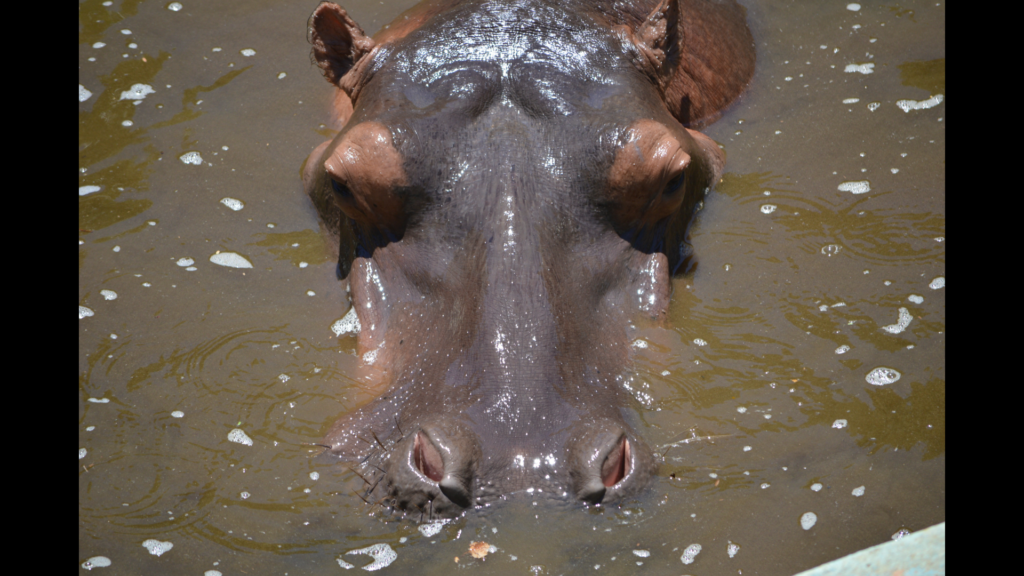
“We now come to the last verse of this noble description: “He taketh it in with his eyes.” These words have also been variously rendered, some translating them as “He receiveth it (i.e. the river) up to his eyes.” But the translation which seems to suit the context best is, “Who will take him when in his sight?” (Wood)
“Story of the Bible Animals by J. G. Wood.” Project Gutenberg, gutenberg.org/ebooks/44685